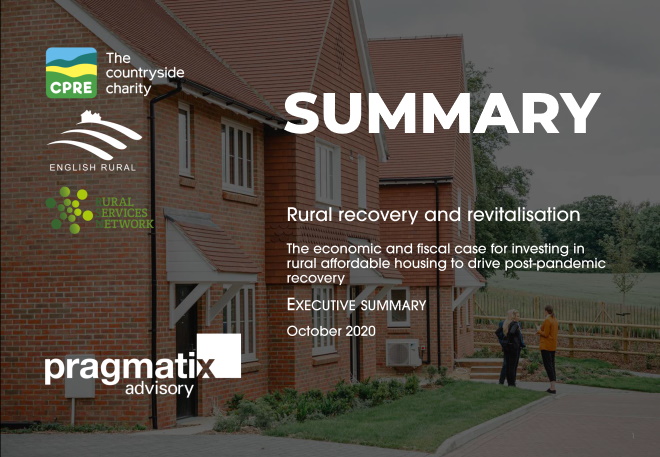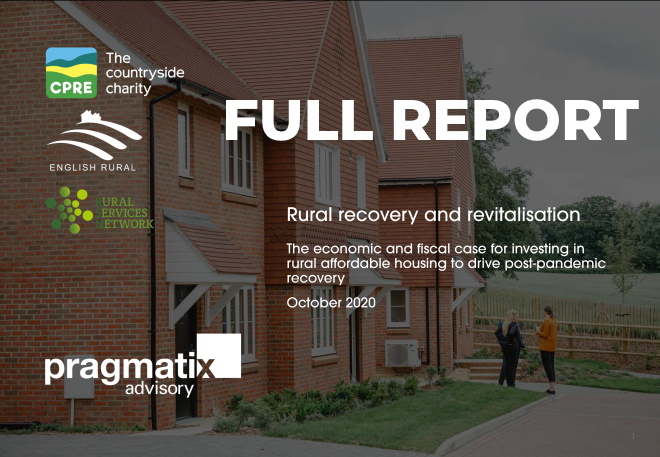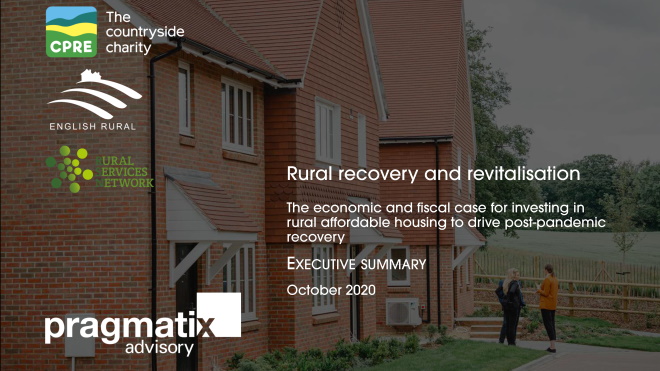T: 01822 851370 E: [email protected]
Visit RSN Survey about life in rural England to find out more.
Rural homelessness doubles since 2018 according to rural campaigners
‘Investing in affordable rural housing will level up and turbo charge the rural economy’ according to new research from CPRE, the countryside charity, English Rural and the Rural Services Network
Homelessness in rural areas has more than doubled in the past two years, according to analysis of government figures from CPRE, the countryside charity. These stark figures come as CPRE, English Rural and the Rural Services Network launch new economic analysis, which shows that investing in affordable housing in rural areas could play a huge role in rebuilding the economy and balancing the government’s books after the pandemic.
Rural homelessness continues to soar unabated and looks set to get worse unless the government acts to invest in well-designed and genuinely affordable homes. The number of households categorised as homeless in rural local authorities rose to 19,975 – an increase of 115% from 2017/18. It is clear that the government needs to invest in rural social housing to get to grips with this problem.
It is well known that affordable rural homes create sustainable communities, but new jointly commissioned research, conducted by Pragmatix Advisory, goes further showing how these homes can help ‘level up’ against rural disadvantage, while also providing a turbo charge for the economy. For every 10 new affordable homes built, the economy will be boosted by £1.4 million, supporting 26 jobs and generating £250,000 in government revenue. When multiplied by the number of affordable homes needed, this would lead to a massive boom in affordable homes, while providing a huge boost to jobs and the economy, saving the NHS and benefits bill thousands of pounds, and even cutting the government’s budget deficit.
However, under the government’s major overhaul of the planning system, there could be even fewer genuinely affordable homes delivered. Rural councils predict potential falls of up to 50% in affordable house building if the duty for developers to build affordable homes – known as the small sites cap – is raised from sites of 10 to 40 or 50 under the government’s proposed changes to the planning system. Countryside campaigners are urging the government to safeguard rural communities by exempting them from proposals.
Commenting on the homelessness figures, Crispin Truman, chief executive of CPRE, the countryside charity, said:
‘Genuinely affordable, well designed homes connected to low carbon public transport and good local services are the very foundations of thriving rural communities. But today’s analysis shows that we are a long way off delivering more of this and tragically, rural homelessness continues to soar. We also know that too many key workers have been priced out of the rural communities they serve – we cannot accept that nine in ten care workers are priced out by private rents.
‘Continuing to deregulate the planning system will only make this situation worse and would be the exact opposite of ‘building back better’. Instead, investing in rural social housing now would deliver a boost to the economy at a time when this is so desperately needed. The evidence is crystal clear that this is the best way to provide affordable homes for rural communities, especially the key workers who communities rely on now, more than ever, while at the same time jump starting the economy.’
The scale of the challenge is unprecedented – at current social housing build rates, it will take more than 150 years to clear rural housing waiting lists[1], and coronavirus will only make this worse.[2]
Welcoming the findings, Martin Collett, chief executive of English Rural Housing Association, said:
‘This research shows both the economic and social value in directing more government investment towards delivering genuinely affordable rural homes. National housing and planning policy for too long has overlooked the needs of the countryside, focusing on urban solutions to rural problems that simply do not work. With rural communities left behind as local people, especially younger households, are priced out of the housing market. The pandemic has reminded us how important it is to have balanced communities, where essential workers both live and work.
‘As a provider of affordable rural homes, English Rural sees first-hand the positive impact that building a small high-quality development has on social and community wellbeing. The work completed by Pragmatix Advisory illustrates the strong economic argument as well, both from a local and national perspective. With homes enabling the economic potential of the countryside, whilst securing a positive financial return for any public investment made.’
The jointly commissioned research highlights the fragility of rural businesses to the economic shock of coronavirus and Brexit. With a dependency on at-risk industries and lack of access to affordable homes, low income rural workers, particularly young families now face heightened risks. Evidence presented through the research shows the dual value of investing in affordable rural homes. They level-up against rural disadvantage whilst providing a turbo-charge for the economy; reducing the national deficit and generating a net return for the treasury.
Graham Biggs, Chief Executive of the Rural Services Network, said:
‘This research and analysis by Pragmatix Advisory is very welcome and timely. The social case for affordable rural housing provision is undeniable and is at the heart of sustainable rural communities. Now the economic case for government investment in such housing is also firmly established we call on the government to boost affordable rural housing supply in a clear win-win situation.’
- You can download both the Executive Summary and the Full Report below:
 |
 |
[1] CPRE analysis of housing waiting lists in predominantly rural local authorities and social housing delivery rates in the same councils shows that at current build rates it would take 154 years to clear the existing backlog
[2] Pragmatix report finds that half a million new homes could be lost by 2024 due to the pandemic




